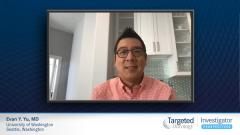
Phase 2 TheraP Trial in PSMA-Positive mCRPC
Evan Y. Yu, MD, reviews the phase 2 TheraP trial evaluating PSA response in patients with PSMA-positive mCRPC who received LuPSMA therapy vs cabazitaxel.
Evan Y. Yu, MD: I believe one thing that helps us when looking at lutetium-177 PSMA [prostate-specific membrane antigen]-617 as an overall package and how and when to use it, is the fact that not only was the VISION trial positive but there was a large, randomized phase 2 trial called TheraP that was recently published in The Lancet. Now, this trial was performed in Australia and New Zealand, I believe. There were about 291 patients, and it was in a similar disease state, but it was a different design. In this trial, their control arm was even more active. They looked at lutetium-177 PSMA-617 versus cabazitaxel on a 1:1 randomization. I think cabazitaxel has established itself as a very good standard of care in the post-docetaxel, post-AR [androgen receptor]–targeted therapy population. There was the CARD trial, which showed that for those patients who were symptomatic, who were progressing very rapidly, who had a short period of response—less than 1 year to prior AR-targeted therapy—cabazitaxel offers a survival benefit versus another AR-targeted therapy. Although cabazitaxel was not allowed in the VISION trial, it was allowed in the TheraP trial. In that trial, PSA [prostate-specific antigen] response was the primary end point. Now, PSA response is never going to get someone an FDA approval there, but I think it helps us understand overall activity. They had PSA response that was about 66%, for a 50% decline or greater with lutetium-177 PSMA-617, versus 37% for cabazitaxel.
I think that that gives you some idea that this might be more active than even cabazitaxel, which is a very strong control arm there. I think the safety, which we haven’t talked that much about, was very well tolerated as well. When you look at the comparison versus cabazitaxel, that’s going to be more toxicity than hormonal agents. You are going see things like more like diarrhea, dysgeusia, neuropathy, and grade 3/4 neutropenia. These are all issues, and they occur at a higher rate with cabazitaxel than with lutetium. In the TheraP trial, toxicity occurred about 13% of the time with cabazitaxel versus 4% with lutetium. The things you see more with lutetium are things like dry mouth, dry eyes, and thrombocytopenia, those sorts of things. You saw an improved PSA decline response, and you saw improved radiographic progression-free survival. Toxicity really laid in favor of lutetium over cabazitaxel. I think that all starts to help us because we are thinking about if we should be using this in the post-docetaxel situation, the post-AR–targeted therapy situation, before or after cabazitaxel. It depends on what the label says when the regulatory approval occurs. Personally, I think that the TheraP trial data help me lean more toward using lutetium-177 PSMA-617 before cabazitaxel rather than after.
The dry mouth or xerostomia adverse effects that can occur with lutetium-177 PSMA-617 exist because PSMA can be expressed on salivary glands, and it can penetrate there and cause more issues with that. Dry mouth is a tough adverse effect; it is not fun for patients. It is not one of those terrible, terrible adverse effects. It is certainly not life-threatening, not like febrile neutropenia or anything, but it is one of those adverse effects that is just a nuisance. What I like to do when I have patients with dry mouth is to talk to them about simple techniques, things they can do and things they can avoid to help them. Now, the first thing everybody talks about is, “Oh, there are over-the-counter saliva substitutes, but they are gross.” They exist for patients who, I think, are in a more extreme situation, but I do not think anybody wants to go buy over-the-counter saliva substitutes. The first thing I do is I say, “Here are things that can further dry your mouth out, so avoid them.” No. 1, patients should be limiting caffeine intake. No. 2, a lot of people use mouthwashes that have alcohol in them, and that can be a drying substance. This is a great opportunity to counsel your patients on cessation of tobacco use, that is smoking or chewing tobacco. Those things can dry your mouth out more. Over-the-counter antihistamines like diphenhydramine, or Benadryl, decongestants, these can make your symptoms worse as well. These are some simple dietary, medication-related, personal and social history habits, things that can be avoided to help prevent a dry mouth. Even simple things like just breathing more through your nose can be helpful. If you are a mouth breather, that can dry your mouth out as well.
In terms of actual things a person can do, not just avoid, but a thing a person can do if they develop the dry mouth, I tell people to sip water regularly. Keep a water bottle by your side and sip water regularly. Other practical things are sugar-free gum. That can induce more salivary production there, and that can help. There are even mouthwashes that are designed for dry mouth. I think ACT Total Care is something; there is Biotène mouthwash. These can be used to help prevent tooth decay, but they can also help stimulate salivary production. Also, sometimes patients have dry rooms, especially when they sleep at night; having an air humidifier in the room can help. There are a lot of things that you can do rather than just saying, “Let’s reach for over-the-counter saliva,” which nobody likes. That is my last-ditch effort, but there are a lot of, I’d say, lifestyle habits one can adapt that can help with xerostomia.
This transcript has been edited for clarity.








































